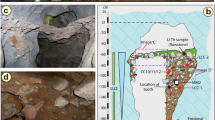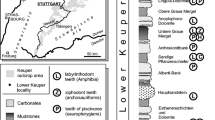Abstract
Molar tooth (briefly called MT) carbonate is one of the Proterozoic carbonates with enigmatic sedimentary structure. According to the morphology of MT, it can be divided into two main genesis-morphology types, i.e., autochthonous and allochthonous, and each type can be further divided into a series of subtypes. The autochthonous MT can be divided into filamentous (MF1), ribbon, nodular and dotted type (MF4), in which the ribbon one can be subdivided into simple vertical (MF2) and complex ribbon (MF3), broken ribbon by storm in situ (MF5) and MT within nodular limestone (MF6). Allochthonous MT includes conglomerate clasts and horizontal detritus. Studying on the links between MT and the host rocks on five stratigraphic sections in the southeastern Jilin and eastern Liaoning indicates that the morphology of MT is closely related to host rocks, and seven genetic types by relationships between MT and the host rocks with facies interpretations are classified and discussed in this paper. The sedimentary environments of MT formation will be diverse if their morphologies are different.
Similar content being viewed by others
References
Smith A G. The origin and deformation of some “Molar-tooth” structure in the Precambrian Belt-Purcell supergroup. J Geol, 1968, 76: 426–433
Failchild I J, Song T R. Possible seismic origin of molar tooth structures in Neoproterozoic carbonate ramp deposit north China. Sedimentology, 1997, 44: 611–636
James N P, Narbonne G M, Sherman A G. Molar tooth carbonates: shallow subtidal facies of the Mid to Late Proterozoic. J Sed Res, 1998, 68(5): 716–722
Pratt B R. Molar-tooth structure in Proterozoic carbonates rocks: Origin from synsedimentary earthquake and implications for the nature and evolution of basins and marine sedimentary. GSA Bull, 1998, 110(8): 1028–1045
Furniss G, Rittle J F, Winston D. Gas bubble and expansion crack origin of “molar tooth” calcite structures in the Middle Proterozoic Belt Supergroup, Western Montana. J Sed Res, 1998, 68(1): 104–114
Meng X H, Ge M. The sedimentary features of Proterozoic microspar (Molar-tooth) carbonates in China and their significance. Episodes, 2002, 25(3): 185–196
O’Connor M P. Classification and environmental interpretation of the cryptalgal organosedimentary “molar-tooth” structure from the late Precambrian Belt-Purcell Supergroup. J Geol, 1972, 80(5): 592–610
Darrel G F L. Tomographic study of Paleoproterozoic carbonates as key to understanding the formation of molar-tooth structure. Gondwana Res, 2007, 12: 566–570
Mark D P, Linda C K, Julie K B. Morphology of Molar-tooth structures in Precambrian Carbonates: Influence of substrate rheology and implications for genesis. J Sed Res, 2006, 76: 310–323
Bauerman H. Report on the geology of the country near the forth-ninth parallel of North latitude West of the Rocky Mountains. Canada Geological Survey of Report Progress, 1882–1884, 1885, part B: 1–42
Qiao X F, Gao L Z, Peng Y. Neoproterozoic in Paleo-Tan-Lu Faulted Zone: Catastrophe, Sequence, Biostratigraphy (in Chinese). Beijing: Geological Publishing House, 2001. 1–128
Qiao X F, Song T R, Gao L Z, et al. Seismic sequence in carbonate rocks by vibrational liquefaction (in Chinese). Acta Geol Sin, 1994, 68(1): 16–34
Du Y S, Zhang C H, Han X, et al. Earthquare events deposit in the Mid-Proterozoic Kunyang Group in center Yuannan and its geological significance (in Chinese). Sic China Ser D-Earth Sci, 2001, 31(4): 283–289
Liu Y Q, Gao L Z, Liu Y X. Microspar structure carbonate and constrain of sedimentary facies and environments in Jiangsu, Anhui and Liaoning provinces of northern China (in Chinese). Acta Sed Sin, 2005, 23(1): 49–59
Kuang H W, Meng X H, Ge M. Discussion on origin for Molar Tooth carbonate rocks: An example from the Neoproterozoic in Jilin-Liaoning area (in Chinese). J Paleogeogr, 2006, 8(1): 63–73
James W B, Dawn Y S. Molar tooth structures of the Neoarchean Monteville Formation, Transvaal Supergroup, South Africa. I: Constraints on microcrystalline CaCO3 precipitation. Sedimentology, 2006a, 53: 1–20
James W B, Dawn Y S, Nicolas J H. Molar tooth structures of the Neoarchean Monteville Formation, Transvaal Supergroup, South Africa. II: A wave-induced fluid flow model. Sedimentology, 2006b, 53: 1069–1082
Kuang H W, Liu Y X, Meng X H, et al. Sedimentary lithofacies and petrological features of Neoproterozoic MT structures-bearing carbonates in Jilin-Liaoning area (in Chinese). Acta Geosci Sin, 2004, 25(6): 647–653
Bureau of Geology and Mineral Resources of Jilin Province. Regional Geology of Jilin Province (in Chinese). Beijing: Geological Publishing House, 1989. 65–81
Bureau of Geology and Mineral Resources of Liaoning Province. Regional Geology of Liaoning Province (in Chinese). Beijing: Geological Publishing House, 1989. 82–123
Meng X H, Ge M. The sedimentary features of Proterozoic micro-spar (Molar-tooth) carbonates in China and their significance. Episodes, 2002, 25(3): 185–196
Kuang H W, Liu Y X, Meng X H, et al. Molar-tooth structure and sedimentary characteristics of the Wanlong Formation of Neoproterozoic at Erdaojiang section of Tonghua County in southern Jilin Province (in Chinese). J Paleogeogr, 2006, 8(4): 457–466
Liu Y Q, Gao L Z, Liu Y X. Neoproterozoic Molar-tooth structure and sonstraint of depositional in the north China platform facies and environment in Jiangsu, Anhui and Liaoning, Eastern China (in Chinese). Acta Geol Sin, 2005, 79(3): 533–539
Author information
Authors and Affiliations
Corresponding author
Additional information
Supported by the National Natural Scientific Foundation of China (Grant No. 40772078), International Geological Correlation Program (IGCP447), (Grant No. SC/GEO/546/447), Foundation of Geology Iustitute, CAGS (Grant No. J0903), Natural Scientific Development Foundation of Yangtze University (Grant No. 2007ZP005)
Rights and permissions
About this article
Cite this article
Kuang, H., Jin, G. & Liu, Y. Genesis types of the Neoproterozoic Molar tooth structures in the southeastern Jilin and eastern Liaoning provinces and its research significances. Sci. China Ser. D-Earth Sci. 52 (Suppl 1), 135–142 (2009). https://doi.org/10.1007/s11430-009-5007-7
Received:
Accepted:
Published:
Issue Date:
DOI: https://doi.org/10.1007/s11430-009-5007-7




